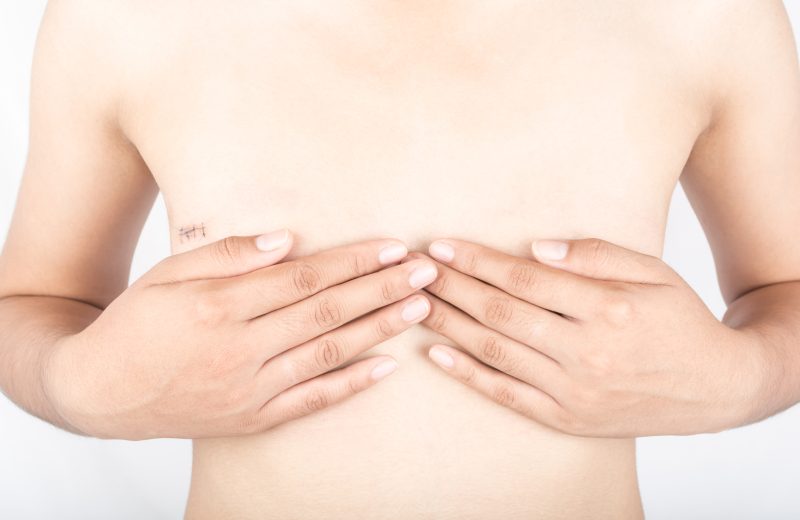PUBLISHED: 14th December 2007

by Melissa Taylor
While I was growing up, my mom seemed to get cancer every several years. She considered cancer to be “her” disease, but I felt a nagging sensation that it might be more. Watching a television program on Hereditary Breast and Ovarian Cancer (HBOC) syndrome and BRCA genetic testing, I recognized the risk factors in our family. I decided then if I ever found I had a genetic mutation, I would have prophylactic mastectomies without reconstruction. That decision came easily because my mom, after each of her cancer-related mastectomies, wore prostheses and went on with life as usual.
Years later, in 2006, a doctor suggested my mom be tested to see if she had a BRCA1/2 gene mutation. Ultimately, my mom, sibling, and I learned we were all positive for BRCA1. I was just in my late 20s. After being concerned for years and working through all the “what ifs,” I already knew what to do, and felt relief that my decision had already been made.
In my experience, doctors seem to default toward reconstruction, especially with people my age. They automatically ask questions about reconstruction: “Would you like to consult a plastic surgeon?” and “Are you going to have reconstruction?” are common. Despite these questions, though, doctors did not try to pressure me in any way. They emphasized that reconstruction would always be an option for me. I especially appreciated the physician who told me about her friend who also decided not to have reconstruction, and was quite happy with her decision.
Many different reasons influenced my decision not to have reconstruction. I saw my mom do well without it. I didn’t want more surgery; after all, I’m only in my twenties. Once I explained my reasoning, everyone was very supportive. My mom remains my staunchest advocate—she feels not having reconstruction helped her find a cancerous lump after her mastectomy. Being sick throughout my childhood and teenage years also helped shaped my choice. While my peers strove to fit in, I spent my formative years learning that my physical looks don’t make me who I am—it is my faith, my soul, my interests. My body is something temporal and has nothing to do with the real me. Besides, I looked this flat before adolescence, and those were some of the happiest years of my life.
For me, not having reconstruction was the right decision. Once I made it, I never wavered. When my bandages came off, I felt my breast cancer surgery experience was over. Being flat is not nearly as obvious as people would imagine, though I went from a thin-bodied C-cup to smaller than AAA! Wearing comfy camisoles helps me to feel feminine and provides that “bra strap” look we’re all used to. Even when I go out without prostheses, I don’t get strange looks or pointed fingers. I realize we’re so much more invisible than we think, and others are not as concerned about our appearance as we tend to be.
The Bible says that true, feminine quality comes not from the outward, but from “your inner self, the unfading beauty of a gentle and quiet spirit.” My hope is that other women, no matter what choices they make regarding reconstruction, will realize their true essence shines from the inside, out.
Melissa Taylor is a career college student pursuing a degree in English. Her illustrations and articles have appeared in both health and pet publications. She maintains a website for women who choose mastectomy without reconstruction.
The Right Decision Is the One That’s Best for You
by Kathy Steligo
Although many women prefer not to have reconstruction, we seem to hear more about the ones that do. Yet there are plenty of sound reasons for not pursuing reconstruction. It means having at least one other surgery (and probably more) and recovery that some women simply can’t endure. In some cases, treatment or other health conditions may preclude you from having immediate reconstruction. Perhaps, like Melissa, the loss of your breasts is not an insurmountable blow to your self-identity.
But if you’re undecided about your postmastectomy options, how do you make that decision? First and foremost, know your options. Weigh the benefits and limitations of each one—both shortterm and long term—before making a decision. Consider the input of loved ones, physicians and other women who have had mastectomy, but ultimately listen to your own heart and mind. Make a decision you can live with. You’re the one, after all, who best knows how you feel about your body. Your decision may not be easy, but it should always be personal.
What to expect from mastectomy
Mastectomy is performed in the hospital under general anesthesia. The surgeon removes the skin, nipple, areola and breast tissue through an oval-shaped incision across the width of each breast. If you have invasive breast cancer, some of your lymph nodes may also be removed. Surgical drains are placed under the skin, where they remain for a week or two to keep fluids from accumulating, and the incision is closed. Typically, mastectomy without reconstruction lasts two to three hours, depending on the type of mastectomy performed. Women are often surprised to feel little or no pain or soreness after mastectomy. You may be numb or have a feeling of heaviness in your chest and a pulling sensation under your arm. You’ll be up walking the day after your surgery, but you’ll need extra rest for several days. Your surgeon will describe exercises to reduce stiffness and gradually return range of motion. It may take 3-6 weeks before you return to your normal routine. After mastectomy without reconstruction, you may want to wear prostheses. You’ll find many different types of varying weight, feel and material. You may decide to wear prostheses all the time, only for certain occasions or not at all. Visit your local mastectomy shop to discover the array of camisoles, bras, prostheses and other post-mastectomy products.
Delayed reconstruction
Reconstruction can be done months or even years after mastectomy. If you change your mind or want to have new breasts when you complete treatment, you can have a delayed reconstruction. Your mastectomy scars will remain across the front of your new breasts, but will fade considerably in time. Even in the future, when stem cells may be prompted to regrow a woman’s breasts after mastectomy, the choice to forego that option will remain. We are, after all, individuals, each with our own sense of self, and the right to personal choice. And for that, we can all be grateful.

Melissa Taylor
4 Comments
November 2, 2024
Male here Genetics here Having both of my Breasts and Lymph nodes removed Left breast has visible Cancer None on the right side Family History of Cancer on Mothers side and Fathers Side. Hope to survive Surgery. Please Pray for me. Thank You Timothy Cummins Tclda10459@Gmail.com
Timothy
Reply
November 13, 2024
Praying for you…..Stay strong…..just diagnosed myself….LEFT Mastectomy soon. We’ll be fine . Lean on Family and Good friends.
Diane
Reply
March 11, 2025
Thank you so much for sharing your story I am facing triple negative breast cancer and currently going to chemotherapy next is a mastectomy without reconstruction your story helped me so much to prepare what I am facing. God bless you.
Patty Thomas
Reply
April 2, 2025
Prayers to all here. My mom caught her triple negative much too late, praying for you Patty, that you caught yours early. I have the palb2 mutation and debating on the recommended preventative surgeries. I would probably not have reconstruction nor would I wear a prosthetic. I like to think I’d embrace the freedom, kind of like being a kid again.
C
Reply